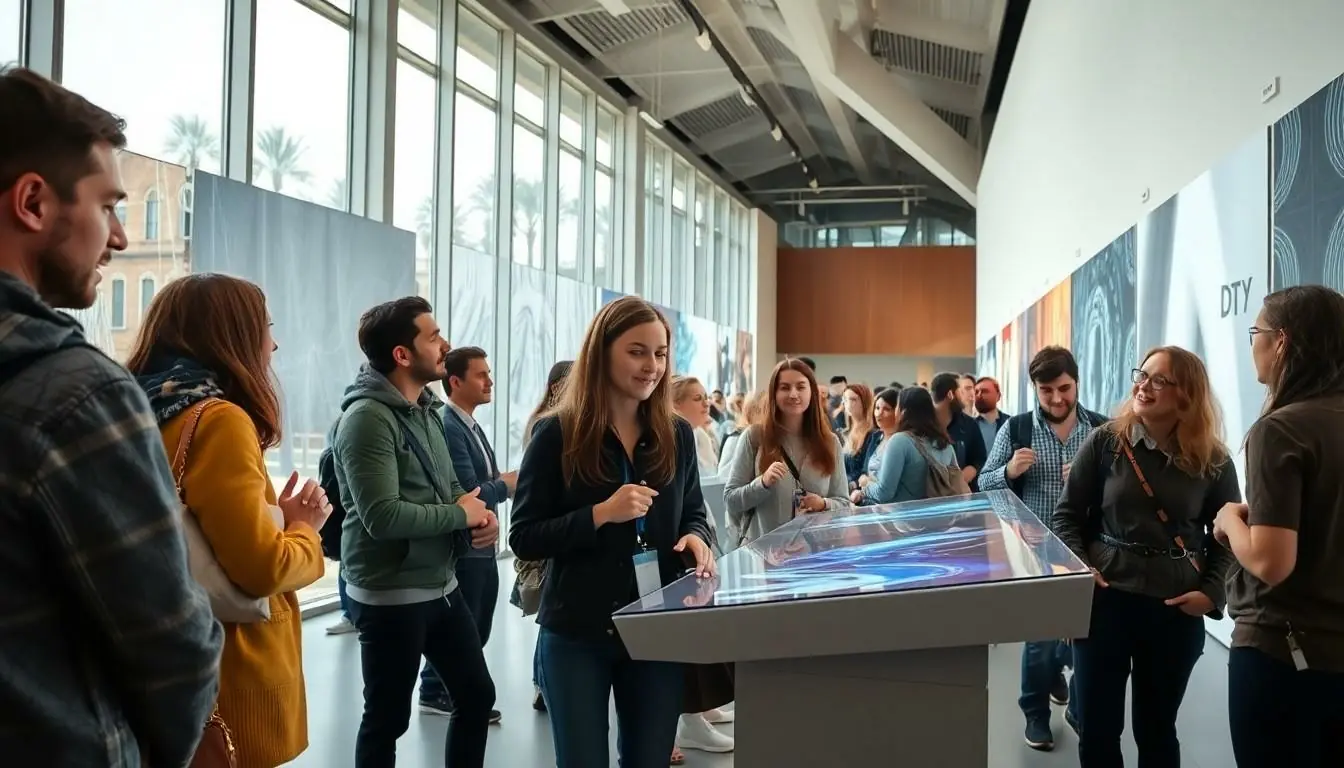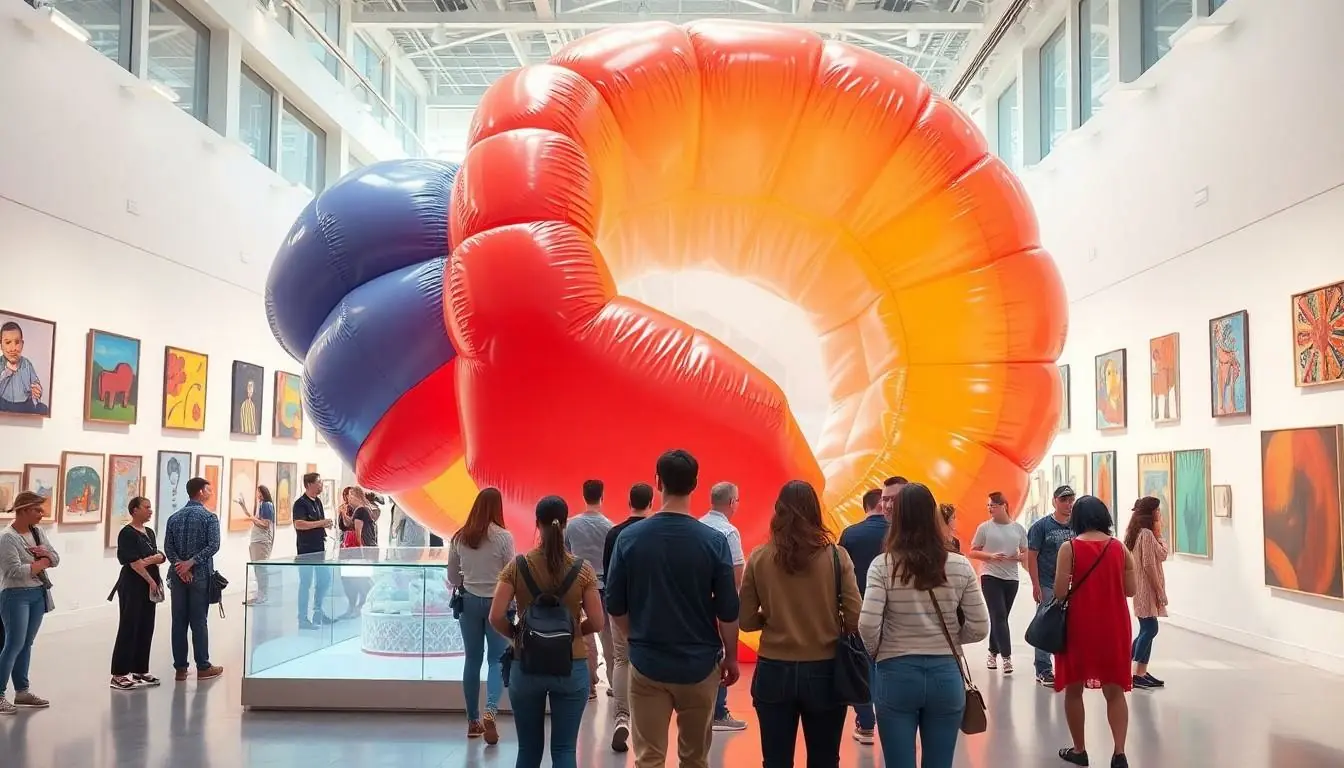Table of Contents
ToggleIn a world where creativity knows no bounds, modern art places stand as vibrant playgrounds for the imagination. These spaces aren’t just galleries; they’re portals to new dimensions of thought, inviting everyone to explore the quirky and the profound. Whether it’s a giant inflatable sculpture or a painting that looks like it was done by a toddler on a sugar rush, modern art challenges perceptions and tickles the funny bone.
What Is a Modern Art Place?
Modern art places serve as spaces dedicated to contemporary artistic expression. These locations encompass galleries, museums, and pop-up installations, each showcasing innovative works. Large sculptures and interactive exhibits often dominate these spaces, inviting viewers to engage more deeply.
Creativity thrives in modern art places, as they encourage artists to experiment with unconventional materials. Visitors encounter diverse art forms, from abstract pieces to immersive experiences. Artists often challenge societal norms, sparking conversations about identity, culture, and technology.
Modern art places foster community interaction, creating a bridge between artists and the public. Workshops, lectures, and events frequently occur within these venues, enhancing appreciation for contemporary art forms. Openings for exhibitions draw crowds eager to experience the latest artistic trends.
Engaging with modern art requires an open mind, as the content often pushes boundaries. Individuals experience a range of emotions, from joy to introspection, while exploring various mediums. Overall, modern art places play a crucial role in shaping cultural landscapes and nurturing creativity.
Features of a Modern Art Place

Modern art places exhibit distinctive characteristics that enhance audience engagement and enrich the artistic experience.
Innovative Architecture
Architectural design significantly influences the visitor experience. Unique structures often stand out as landmarks in urban landscapes. These buildings blend functionality with artistic creativity, creating spaces that inspire. Natural light frequently floods galleries, highlighting artworks and enhancing appreciation. Unconventional shapes and layouts encourage exploration while sparking curiosity. For example, a spiral staircase may lead to an open rooftop space, offering panoramic views of the cityscape. As visitors wander, each corner reveals new perspectives on contemporary art.
Interactive Exhibits
Engagement increases in environments featuring interactive exhibits. These displays often invite participation, allowing viewers to immerse themselves in the artwork. Touch-sensitive installations enable hands-on experiences that evoke deeper emotional responses. Visitors might manipulate light or sound, creating personalized artistic encounters. Collaborative artworks encourage group involvement, fostering community connections. Innovative technology often integrates virtual reality or augmented reality, enhancing the viewing experience. Each interactive element transforms passive observation into active participation, making modern art accessible and relatable.
Importance of Modern Art Places
Modern art places foster an appreciation for creativity and innovative expression. These venues significantly impact cultural dialogue and education.
Cultural Impact
Modern art places reflect societal changes, acting as platforms for marginalized voices. They engage communities, encouraging familiarity with contemporary issues through visual storytelling. Local events often attract diverse audiences, facilitating discussions around identity and technology. Artworks serve as powerful catalysts for change, pushing viewers to reconsider norms and expand their understanding of culture. Public art installations create shared experiences, bringing people together and fostering connections. By showcasing groundbreaking ideas, modern art spaces help define cultural landscapes and inspire future generations.
Educational Value
Modern art venues provide valuable learning opportunities for all ages. Many incorporate workshops and lectures that enhance understanding of artistic techniques and concepts. Students often engage in hands-on activities that strengthen creative skills and critical thinking. Exhibitions frequently highlight the intersection of art and technology, offering insights into contemporary creative practices. Collaborations with educational institutions enrich curricula and promote art appreciation. Guided tours and interactive exhibits make learning accessible and enjoyable, fostering a deeper connection to the art world. Through these initiatives, modern art places become integral to educational growth and artistic enlightenment.
Notable Modern Art Places Worldwide
Modern art places around the globe serve as cultural beacons, showcasing innovative works that captivate audiences. The Museum of Modern Art (MoMA) in New York highlights masterworks from celebrated artists, making it essential for art enthusiasts. Tate Modern in London features contemporary artworks in an iconic former power station, creating a unique viewing experience.
In Paris, the Centre Pompidou stands out with its radical architectural style and vast collection of modern masterpieces. The Guggenheim Museum in Bilbao, Spain, boasts an eye-catching design by Frank Gehry, drawing visitors with its innovative exhibits.
In Asia, the 21st Century Museum of Contemporary Art in Kanazawa, Japan, focuses on fostering dialogue between different art forms and providing immersive installations. The Singapore Art Museum emphasizes Southeast Asian art, showcasing new and experimental practices that resonate with local culture.
Australia’s National Gallery of Australia presents a diverse range of contemporary art, emphasizing works from both indigenous and international artists. The Pérez Art Museum Miami engages with its waterfront location, offering outdoor installations that inspire conversations about nature and sustainability.
Colombia’s Museo de Arte Moderno is significant for promoting emerging artists while fostering cultural discussions. Internationally, various art fairs, like Art Basel and Frieze, feature booths from modern art places, emphasizing the global dialogue in contemporary art.
Each venue contributes uniquely to the artistic landscape, enriching cultural discussions and facilitating community engagement. Collectively, these modern art places inspire creativity and provoke thought, reinforcing their roles in today’s dynamic art world.
Modern art places are vital to the cultural landscape and play a crucial role in shaping contemporary artistic expression. They not only showcase innovative works but also invite viewers to engage with art in meaningful ways. By fostering community interaction and encouraging dialogue around pressing issues, these venues create shared experiences that resonate with diverse audiences.
As they continue to evolve, modern art spaces will remain essential in inspiring creativity and challenging perceptions. Their unique blend of art, technology, and architecture ensures that they remain at the forefront of cultural conversations. Embracing the transformative power of modern art, these spaces will undoubtedly influence future generations and continue to redefine the boundaries of artistic expression.






